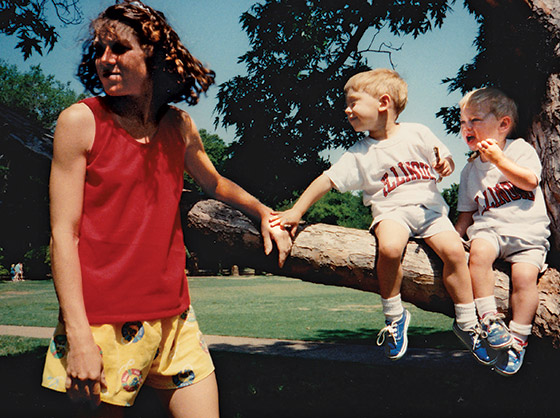 |
Su with Patrick and Benjamin in 1990.
(Photo: Courtesy of Su Meck) |
“It was weird,” Su said. It wasn’t until several days later that it occurred to her “that she was referring to that Su who was that crazy, wild thing. And I thought, Wow, maybe there is still some of that in me.”
By then the sky had begun darkening outside and the sounds of the insects were increasing. The children had never left the conversation, even as Kassidy lay on the couch perusing her iPhone and Benjamin sat at the table perusing his laptop. I asked Su if it ever bothered her that her children seemed to answer for her so often. “I prefer it,” she said. “They kind of know how I feel about things. So sometimes if I can’t come up with the right words, they can. Plus, they know the stories better than I do.”
Strangely, at that moment I began experiencing the feeling of déjà vu. When I shared this with Su, she looked at me blankly. Benjamin, Kassidy, and I all did our best to explain.
Su considered it for a moment. “No,” she said then with absolute certainty, “I’ve never experienced that.” Fern and Farley were on the floor, asleep, shaking their legs as if running. For a long time after her injury, Su said, she did not understand where she went or what was happening when she was dreaming.
In conversation, Su refers to the person she had been until her accident as “her.” “To me,” Su told me, “that was Su’s life. This is mine.”
That Su grew up the fourth of five children in Ohio and moved to the Main Line outside Philadelphia around the time of high school. She was intelligent, athletic, stubborn. Of her former self, Su wrote, “She broke rules; I follow them. She drank and smoked pot; I don’t even know the taste of beer or wine, and the smell of smoke makes me physically ill. I like vegetables; she hated them. She loved to swim; I am absolutely terrified of water. I have no idea what falling in love feels like, yet I have been married for almost 30 years.”
Su met Jim Meck her freshman year at Ohio Wesleyan University; he was two years older and had spotted her in the campus Look Book. Despite her parents’ fierce objections, she dropped out when Jim graduated, married, and relocated with him to North Texas, where she became pregnant with Benjamin and, less than one year later, Patrick. Jim wrote software for F-16s at Carswell Air Force Base. At home, she entertained the kids and herself by playing records of her idols: Neil Peart from Rush, Keith Moon from the Who, Nick Mason from Pink Floyd.
On the evening of Sunday, May 22, 1988, they were in the kitchen. The ceiling fan overhead was off. Jim was at the table reading the Ft. Worth Star-Telegram; she was at the stove, dumping globs of Velveeta into a pot of macaroni while trying to keep an eye on Patrick, who was creeping along the floor; Benjamin, whose 2nd birthday was days away, sat in his highchair, chewing on Cheerios. They’d recently bought their tiny ranch house and had begun to settle in. Earlier that day, they’d attended Ft. Worth Presbyterian church, and they were discussing renting a movie once the kids had been put to bed. There was a strange, horrible sound. Jim put his paper down. She was holding out Patrick to hand to him and simultaneously collapsing, blood trickling down her forehead, the ceiling fan dangling from an electrical wire, swaying low.
Her initial prognosis was dire. She’d suffered what was then classified a “closed head injury”—the only substantial external manifestation was a one-inch gash on the right side of her forehead, near her temple, but imaging showed fluid collecting inside her skull. For the most part, treatment involved withholding treatment, in the hope that her body could reverse course on its own. In the ICU, she flitted between being awake and asleep. Jim kept her parents apprised via a pay phone in the lobby.
When Jim returned to the hospital early the following morning, a nurse prepared him: “Your wife doesn’t know her name.” Nor, as he walked into her room, did Su know him. Yet over the next two weeks, as she regained control of her physicality, everyone—Jim, her parents, and especially the doctors, nurses, and therapists who treated her—was highly sanguine. Even as evaluations yielded shifting results: Su could not hold herself upright in a chair and fell out repeatedly; she could walk; she could not read or write and barely spoke; she began discussing The Catcher in the Rye. According to her medical records, Jim was growing increasingly impatient. A social worker noted that “Mr. Meck insisted on accelerated therapy based on her exceptional progress over the weekend.”
 Subscribe
Subscribe

 The Age of the Auteur in Streaming TV
The Age of the Auteur in Streaming TV
 The Approval Matrix
The Approval Matrix David Edelstein on This Is Where I Leave You
David Edelstein on This Is Where I Leave You
 A Very Different Kind of Sexual Revolution on Campus
A Very Different Kind of Sexual Revolution on Campus
 Derek Jeter, in Private
Derek Jeter, in Private
